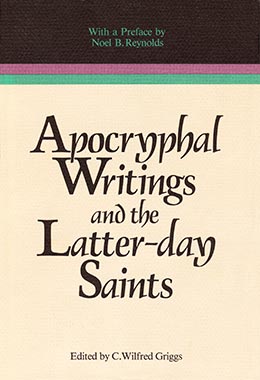Preface
Noel B. Reynolds, Associate Academic Vice President
Preface to Apocryphal Writings and the Latter-day Saints, ed. C. Wilfred Griggs (Provo, UT: Religious Studies Center, Brigham Young University, 1986), ix–x.
The ironies of history can be instructive, and especially so when they occur in divine history. The Christian world in 1830 accepted the Bible as the complete and infallible word of the Lord. And it protected the integrity of that scriptural canon by labeling all other claimed scriptural texts “apocryphal.” But the seeds of skepticism were already being sown among Jewish and Christian scholars that would eventually lead these traditional Bible communities to take a much less believing view of their canonical scriptures.
Joseph Smith’s contemporary critics clearly regarded his contributions to scriptural literature as “apocryphal” in this same negative and self-serving sense. But they would not have acknowledged that these texts were also apocryphal in the ancient sense, being hidden, sacred records now delivered to the Saints through the powers of heaven. Rather, they saw in Joseph’s new records, and in his view that the Bible may not be without errors, a lukewarm commitment to the basic Christian canon. The irony is that today Joseph Smith’s “apocryphal” scriptures are the strongest available evidence of the historicity and validity of the Bible, which has been deserted on all sides. And his followers are among the few who continue to believe the biblical canon.
Given also our belief that the Lord “will yet reveal many great and important things pertaining to the Kingdom of God,” no one should be surprised at the interest Latter-day Saints have in ancient religious records which might illuminate the scriptural legacy of earlier dispensations, or help prepare them for additional restoration of scriptures through the prophets. The last 150 years have been replete with significant discoveries and publications of manuscripts claiming to be sacred writings in the Judaeo-Christian heritage of prophecy and revelation. Although scholars have relegated most of these writings to the category of forgeries, some may represent traditions as authentic as those contained in the scriptural canon.
It was appropriate, therefore, that invited participants gather at Brigham Young University on October 11 – 12, 1983, to share prepared papers on various aspects of the general topic, “Apocryphal Literature and the Latter-day Saints.” Through the combined efforts of these participants and the editor, we are now able to share those papers with the much larger audience of interested persons who were not able to attend the symposium. Because each author selected his own topic, the collection of essays does not represent a systematic or comprehensive approach to the subject. It should also be noted that each paper presents the opinion of its author, and not necessarily the position of the other participants, of Brigham Young University, or of The Church of Jesus Christ of Latter-day Saints. The editor and the participants hope that the different viewpoints and opinions expressed in the essays will assist readers in appreciating and understanding better the significance of this growing body of apocryphal texts.
Appreciation should be expressed to the Religious Studies Center of the university and its director, Dean Robert J. Matthews of Religious Education, for sponsoring symposia on significant topics; and also to the Ancient Studies arm of the center, to its secretary, Mrs. Connie Gaither, and most of all to its director, Professor C. Wilfred Griggs, for organizing this symposium and editing the papers for publication. The university looks forward to many such programs for the benefit and enlightenment of its students, faculty, staff, and friends.
